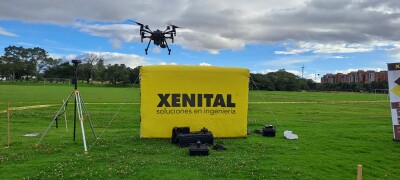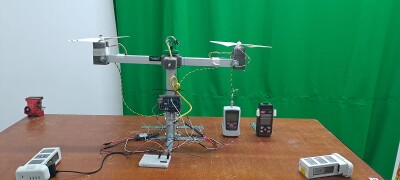In our constant search for innovative and original ways to use uncrewed aviation to perform traditional commercial or industrial tasks in a different and more efficient manner, we come across examples of ingenuity and creativity all over the world.
This time we found a company in Colombia that had to combine 27 different technologies to accomplish a specific task. Xenital, a Bogota-based engineering company, had to dig deep into the existing technology pool to find the different components of a solution that the customer required. We connected with Sebastian Uribe, founder and CEO of Xenital, for a fascinating conversation about his company and the challenges of creating workflows with drones.
 “For years, I worked for a large, traditional engineering company here in Colombia but when I heard about drones, I immediately proposed to management to add them to our existing solutions to reduce costs and time in our processes,” Uribe said. “Unfortunately, my proposal fell on deaf ears, so I decided to resign and create my own engineering enterprise with the sole focus of improving everything I knew how to do with the aid of an uncrewed aircraft.”
“For years, I worked for a large, traditional engineering company here in Colombia but when I heard about drones, I immediately proposed to management to add them to our existing solutions to reduce costs and time in our processes,” Uribe said. “Unfortunately, my proposal fell on deaf ears, so I decided to resign and create my own engineering enterprise with the sole focus of improving everything I knew how to do with the aid of an uncrewed aircraft.”
Colombia has one of the most challenging geographies of any country in the northern hemisphere. It is where the Andes emerge from the ground, creating the longest continental mountain range in the world, extending for thousands of miles south all the way to Patagonia in Chile. When you combine these tall mountains with a tropical climate, you get a challenging mixture of high slopes and thick, humid forest.
“From the engineering point of view, Colombia present unique challenges to road designers and builders,” Uribe said. “Bridges have to be constructed with huge provisions for landslides, earthquakes and constant humidity, and sometimes, even with all these added safety features, a structure collapses, bringing isolation to entire communities. In Colombia, we live in a constant state of building and rebuilding.”
This cyclical environment of built-by-humans and destroyed-by-nature has created an industry for constant preventive inspections, as well as after-the-accident reviews and analysis. Xenital has created specific workflows for both scenarios, and the use of drones alone was not providing engineers with the answers they were looking for.
“Flying a collapsed bridge in a dense forest and slopes of over 45o is not only challenging, but if you don’t have the right sensors, the resulting data might be useless,” said Uribe. “This is where we decided to be bold and to add different sensors and multiple approaches to make sure our product would be exactly what the engineers need to determine what happened and how to prevent it from happening again. It’s a huge responsibility.”
 Currently, the government of Colombia is embarked in an ambitious project to add more rural paved roads and bridges to give access to isolated communities but also enhance the public transportation networks in cities such as Bogota, which suffers from chronic traffic jams due to the challenging nature of its mountainous geography.
Currently, the government of Colombia is embarked in an ambitious project to add more rural paved roads and bridges to give access to isolated communities but also enhance the public transportation networks in cities such as Bogota, which suffers from chronic traffic jams due to the challenging nature of its mountainous geography.
“We are helping the engineers building the Bogota Metro with constant volumetric calculations in order to keep track of excavations and earth movements,” Uribe stated. “It is forecasted that the excavation for the metro will move 1.6 million cubic yards of dirt that needs to be accounted for, and the traditional method of using multiple ground crews was becoming unviable as the construction became more complex. Our proposal to do it constantly from the air without interfering with ground operations was received with enthusiasm by the building company, and now we are constantly flying and calculating with a high degree of accuracy daily earth movements around the excavation sites.”
As roads and bridges are constructed, the need to monitor them and keep an eye on structural weakness opens a new business opportunity that Xenital approached with laser scanners and ground vehicles.
“Using 360o cameras and high precision GNSS receivers, we were able to create a truck that we could drive on all sorts of roads and form an accurate photogrammetric model of all structures that engineers can use to monitor the health and maintenance needs of specific routes,” said Uribe. “There are over 9,000 miles of roads in Colombia that need to be monitored, and we have integrated a number of technologies to create a system that can do the job faster and more accurately. We expect this industry to be one of our greatest revenue generators for years to come at a national and international level.”
Constant humidity and persistent fog and mist in high areas has also created a new engineering problem of a different sort: corrosion in cellular towers. To address the problem, Xenital has created a workflow using BIM (Building Information Modelling) to help telecommunications companies perform preventive maintenance and avoid service interruptions.
“Cell towers are a bit outside of our traditional construction scope but when we heard of the constant failure rate of these indispensable communication tools, we decided to create a workflow specifically designed to efficiently fly the tower with a couple of sensors and in record time create a 3D model that would give engineers the information they need to assign repair or maintenance crews to specific parts in designated towers. It was a hit and now we are expanding into other regions of the country,” Uribe reported.
It is clear by now that the use of small uncrewed aviation is changing the face of engineering in a plethora of areas and industries. Xenital is another example of what ingenuity and creativity can do when environmental realities conflict with the need to communicate with each other and also provide ways of people to move from one place to the next, opening trade routes and improving the lives of everyone involved.















Comments